For 4×4 and off-grid enthusiasts, the Next Generation Ultra Slim series from Custom Lithium takes compact, high-capacity lithium batteries to the next level.
Building on the standard Ultra Slim range, these batteries are designed for improved performance, higher energy capacity, and enhanced durability in harsh off-road conditions.
The Next Generation Ultra Slim line-up covers a broad range of capacities, including 100 Ah, 200 Ah, 230 Ah, 280 Ah, 310 Ah, 400 Ah, 460 Ah, 560 Ah, and 620 Ah, providing options for everything from short weekend trips to extended overland journeys. Compared with the original Ultra Slim series, the next generation models offer higher usable energy, more consistent voltage output, and increased maximum continuous discharge, making them better suited for 4WDs, camper trailers, and off-grid systems running multiple appliances.
These batteries use upgraded LiFePO₄ cells with refined chemistry for longer life and enhanced thermal stability. Each unit also includes an advanced Battery Management System (BMS) with improved safety features, ensuring protection against overcharging, over-discharging, and overheating even under heavy off-grid loads.
The slim, compact form factor remains a key advantage, allowing installation in tight spaces such as under seats, in canopy compartments, or behind storage panels, while still delivering more power than the original Ultra Slim range. This makes them ideal for fridges, lights, water pumps, winches, and other essential off-road accessories without compromising payload or vehicle layout.
For serious overlanders and off-road travellers, the Next Generation Ultra Slim series offers higher performance, more capacity, and improved reliability compared with the standard Ultra Slim batteries, making it a practical upgrade for any 4×4 or camping setup.
For 4×4 owners who spend time off the beaten track, a reliable dual-battery setup is essential.
Custom Lithium dual-battery systems are designed to provide independent, high-capacity power for your vehicle’s accessories while keeping the starter battery fully charged and ready to go. These systems are particularly useful for powering fridges, lights, winches, water pumps, and other gear on extended trips or off-grid adventures.
Custom Lithium offers vehicle-specific dual-battery systems for a wide range of popular 4x4s, including:
- Ford Everest and Ranger
- Isuzu MU-X and D-MAX
- Jeep Gladiator
- Nissan Navara NP300 and Patrol Y62
- Toyota HiLux (N70 and N80)
- Toyota LandCruiser 79
- VW Amarok
- Mazda BT-50
Each system is designed for easy integration with the vehicle’s existing electrical setup and comes with LiFePO₄ lithium batteries for lightweight, high-capacity power. Integrated Battery Management Systems (BMS) ensure protection against overcharging, over-discharging, and overheating, keeping both batteries safe and reliable in remote conditions.
Compared with standard lead-acid dual-battery setups, Custom Lithium systems offer more usable energy, longer lifespan, and consistent voltage output. The lithium batteries maintain steady power for accessories throughout the trip, reducing the risk of running out of energy for critical equipment.
For off-road enthusiasts and overlanders, these dual-battery systems provide a turnkey solution to power camping fridges, lights, and other accessories, while ensuring the starter battery is always ready to start the engine. Vehicle-specific designs make installation straightforward and maximise space efficiency within the engine bay or tray.
With Custom Lithium dual-battery systems, your 4×4 setup can handle extended off-grid trips with reliable, long-lasting power for all your accessories.
The Custom Lithium Compact series offers high-capacity lithium batteries in a slightly larger form factor.
This range is ideal for vehicles, camper trailers and canopy setups where the slightly taller Slim or Ultra Slim batteries may not provide enough capacity for extended trips or heavier setups.
The Compact series includes 200 Ah, 230 Ah, 280 Ah, and 310 Ah options, giving users flexibility depending on power requirements. Smaller capacities are suitable for weekend trips, running a fridge, lights, or a water pump, while the 280 Ah and 310 Ah models can support longer tours or rigs with multiple accessories.
Compared with the Ultra Slim series, Compact batteries are larger but provide higher total energy and can handle higher continuous loads. Compared with the Slim series, the Compact range trades a little extra physical space for increased capacity, making it better suited for vehicles with room for taller battery boxes or dedicated storage compartments.
All Compact batteries use LiFePO₄ cells, delivering stable voltage, consistent output, and long cycle life. Integrated Battery Management Systems (BMS) protect against overcharging, over-discharging, and overheating, ensuring reliable performance in remote or off-road conditions.
For 4×4 and camping enthusiasts, the Compact series provides dependable, high-capacity power for fridges, lights, water pumps, winches, and other essential accessories.
By combining higher energy capacity with robust construction and protective systems, the Custom Lithium Compact batteries are a practical choice for overlanders, long-distance travellers and anyone looking to upgrade their off-grid power setup.
The Custom Lithium Slim series provides high-capacity power in a slightly taller format than the Ultra Slim range, offering more flexibility where space is available.
This makes Slim batteries well-suited for camper trailers, canopies and vehicles where under-seat or low-profile Ultra Slim units may not fit. The Slim range includes 100Ah, 200Ah and 230Ah models, allowing users to choose a battery that matches their power needs.
Smaller capacities are ideal for running fridges, lights, or water pumps on short trips, while the larger 200Ah and 230Ah units can support longer tours or setups with multiple accessories. Compared with the Ultra Slim series, Slim batteries trade a slightly taller profile for a practical balance of capacity and installation versatility, making them easier to integrate into mid-sized compartments or modular setups.
These batteries use LiFePO₄ (lithium iron phosphate) cells, providing stable voltage, long cycle life, and consistent output. Each includes an integrated Battery Management System (BMS) to protect against overcharging, over-discharging, and overheating – features that are particularly important for off-road and remote use. For 4×4 drivers, campers, and overlanders, the Slim series provides reliable, consistent power for fridges, lights, water pumps, and other essential gear.
By offering a balance between size, capacity, and durability, the Slim range is a practical alternative to Ultra Slim batteries when a little extra space is available without compromising vehicle layout or payload.
For 4×4 owners, space and weight are often just as important as raw power. The Custom Lithium Ultra Slim series delivers high-capacity lithium batteries in a compact format, designed to fit into tight spots in vehicles, camper trailers, or canopies.
The range spans from 100 Ah to 310 Ah options, letting users choose the right size for their setup. Smaller capacities are useful for short trips or running a fridge and lights, while the larger batteries can support longer tours with multiple appliances.
These batteries use LiFePO₄ (lithium iron phosphate) cells, which provide long life, stable voltage, and consistent performance. Each unit has a Battery Management System (BMS) to protect against overcharging, over-discharging, and overheating – features that are particularly useful for off-road conditions and remote campsites.
The slim design makes them easy to fit under seats, behind panels, or in canopy compartments, while the reduced weight frees up payload for gear and supplies. For 4×4 drivers, this combination of compact size, light weight, and reliable capacity makes installation simpler and setups more efficient.
In practical terms, the Ultra Slim batteries can run fridges, lights, water pumps, and other accessories without the usual limitations of older lead-acid batteries. They also maintain steady power throughout the discharge cycle, so your gear operates consistently until the battery is almost empty.
For anyone spending time off the beaten track, the Custom Lithium Ultra Slim series provides a dependable, space-conscious solution to power your 4×4, camper, or off-grid setup – keeping your gear running reliably no matter where the journey takes you.
Custom Lithium, based in Brisbane, manufactures Australian-designed LiFePO₄ lithium batteries for 4WDs, caravans, RVs and off-grid setups. Its focus is on compact, high-capacity power solutions that handle tough conditions in remote areas.
Battery Packs
Ultra Slim Series: Lightweight and compact, ideal for tight spaces under seats or canopy floors. Capacities include 100Ah, 200Ah, 280Ah and 310Ah.
Compact Series: Suited for medium off-grid setups like caravans. Models range from 200Ah to 310Ah, housed in sturdy enclosures.
Slim Series: Streamlined batteries for spaces where height or width is limited, while still offering reliable power.
Caravan & RV batteries: High-capacity packs from 400Ah to 620Ah with integrated BMS and active balancing for consistent performance on longer trips.
48V system battery: 100Ah option for higher-voltage applications, pre-assembled with BMS and suitable for larger RV or caravan setups.
Batteries come in 12V, 24V (200, 280 and 310Ah) and 48V configurations, covering a range of vehicle and off-grid system needs.
Vehicle-specific kits and off-road solutions
Custom Lithium also provides kits for 4WDs, camper trailers and touring rigs, with batteries designed for canopy mounts, under-seat storage or modular builds. These solutions make it easier to integrate lithium batteries into existing setups.
It offers practical accessories such as mounting brackets, battery monitors and chargers to help 4×4 and camping setups run efficiently.
Why 4×4 owners and campers choose lithium
- Space-efficient: Batteries fit into tight vehicle or trailer spaces.
- High capacity: Enough power for fridges, lights, induction cookers and accessories on extended trips.
- Reliable: LiFePO₄ cells, high-current BMS, and active balancing provide long-lasting, consistent power even in harsh conditions.
For off-road and camping enthusiasts, Custom Lithium batteries deliver compact, reliable, high-capacity power that keeps rigs and setups running on extended trips.
For anyone who’s spent time touring Australia, one truth becomes clear: the gear you take with you is only as good as its weakest link.
Power, in particular, can make or break a trip. That’s where Custom Lithium, a family-owned company out of Brendale, Queensland, has carved out a reputation among 4×4 owners and travellers.
Founded with the goal of producing ultra-compact, high-capacity lithium batteries, Custom Lithium’s products are designed to cope with the punishing conditions that remote touring dishes out. From corrugated tracks in the desert to humid coastal campsites, reliability is what makes the difference between a hassle-free adventure and a ruined trip.
Custom Lithium sells Australian-made lithium batteries for caravans, 4x4s and off-grid applications. The product range includes Ultra Slim, Slim, and Compact 12V batteries (100–310 Ah) for tight spaces, high-capacity caravan and RV batteries (400-620 Ah), and 24V/48V system batteries for higher-voltage setups.
Also in the catalogue are vehicle-specific kits and off-road power solutions, along with accessories such as mounting brackets, battery monitors and chargers, all designed to integrate seamlessly into touring rigs, camper trailers and 4WD setups.
But there’s more to the business than just the batteries themselves. Custom Lithium has taken a deliberately community-first approach, putting as much energy into supporting local clubs, grassroots sport, and community projects as it does into product development. It’s a philosophy rooted in family values – one that resonates strongly with the 4×4 community, where mateship and support networks are central to the lifestyle.
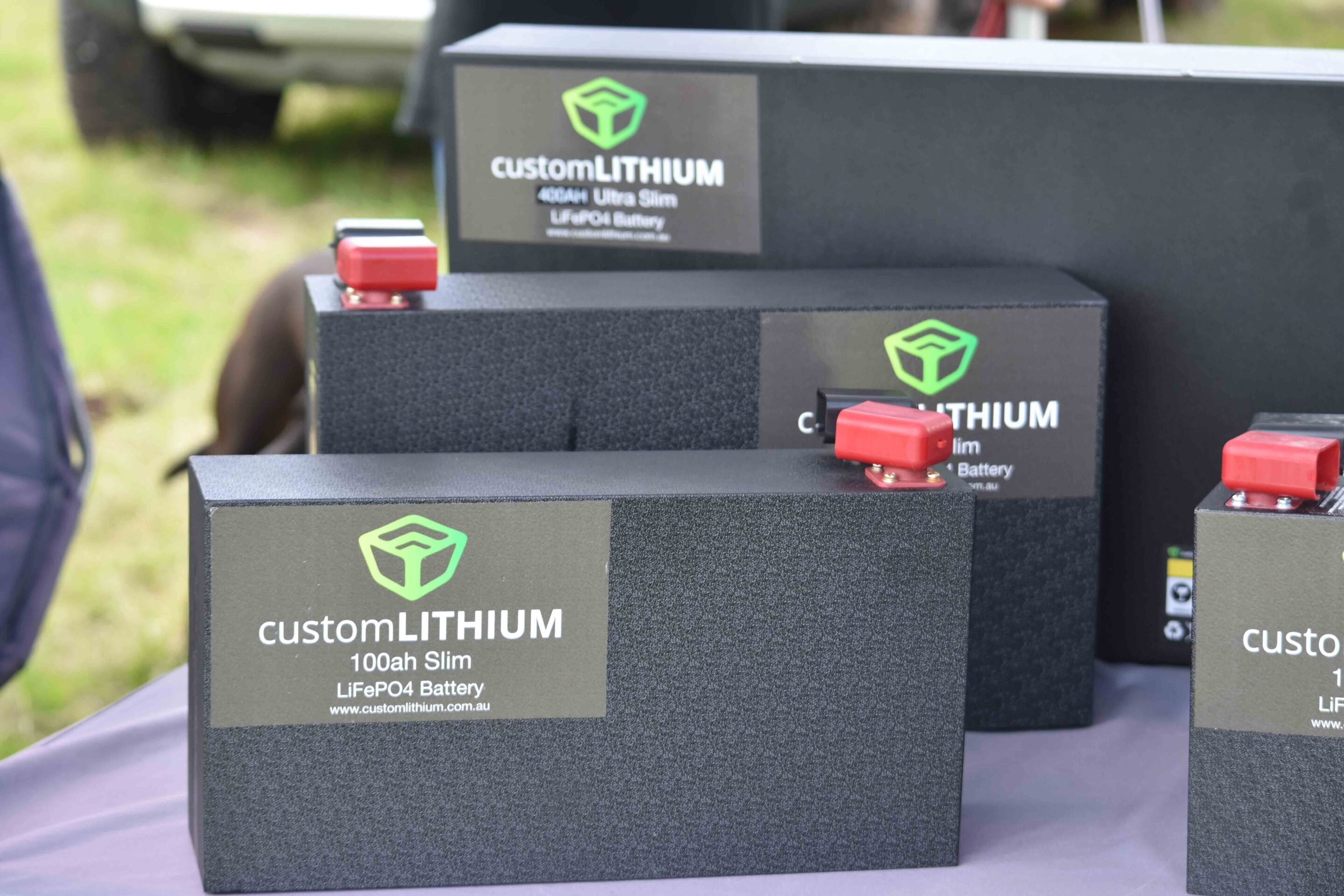
The company’s partnerships aren’t about slapping a logo on a jersey. Each one is chosen for its real impact, whether that’s helping a junior team stay on the field or backing projects that create lasting change. In this way, the story of Custom Lithium is as much about people as it is about technology.
For off-roaders, it’s a reminder that choosing Australian-made gear can carry broader benefits. Investing in a Custom Lithium setup means not just securing dependable power for the track, but also helping sustain a business that puts community and values at the heart of its operation.
Chevrolet Silverado 1500 LTZ, 1500 ZR2 and 2500 HD models sold in Australia will now come standard with a five-year, unlimited-kilometre manufacturer warranty.
The move, announced by GMSV, replaces the current three-year/100,000km coverage and extends roadside support to match – with five years of 24/7 Ultra Roadside Assistance now included.
The change brings the Silverado in line with what’s become the norm in the local ute and 4×4 wagon market, where longer warranty periods are increasingly expected by buyers.
It’s worth noting the new warranty only applies to vehicles delivered on or after 1 October 2025. Any Silverado 1500 or 2500 HD delivered before that date will remain under the existing three-year/100,000km warranty and roadside package.
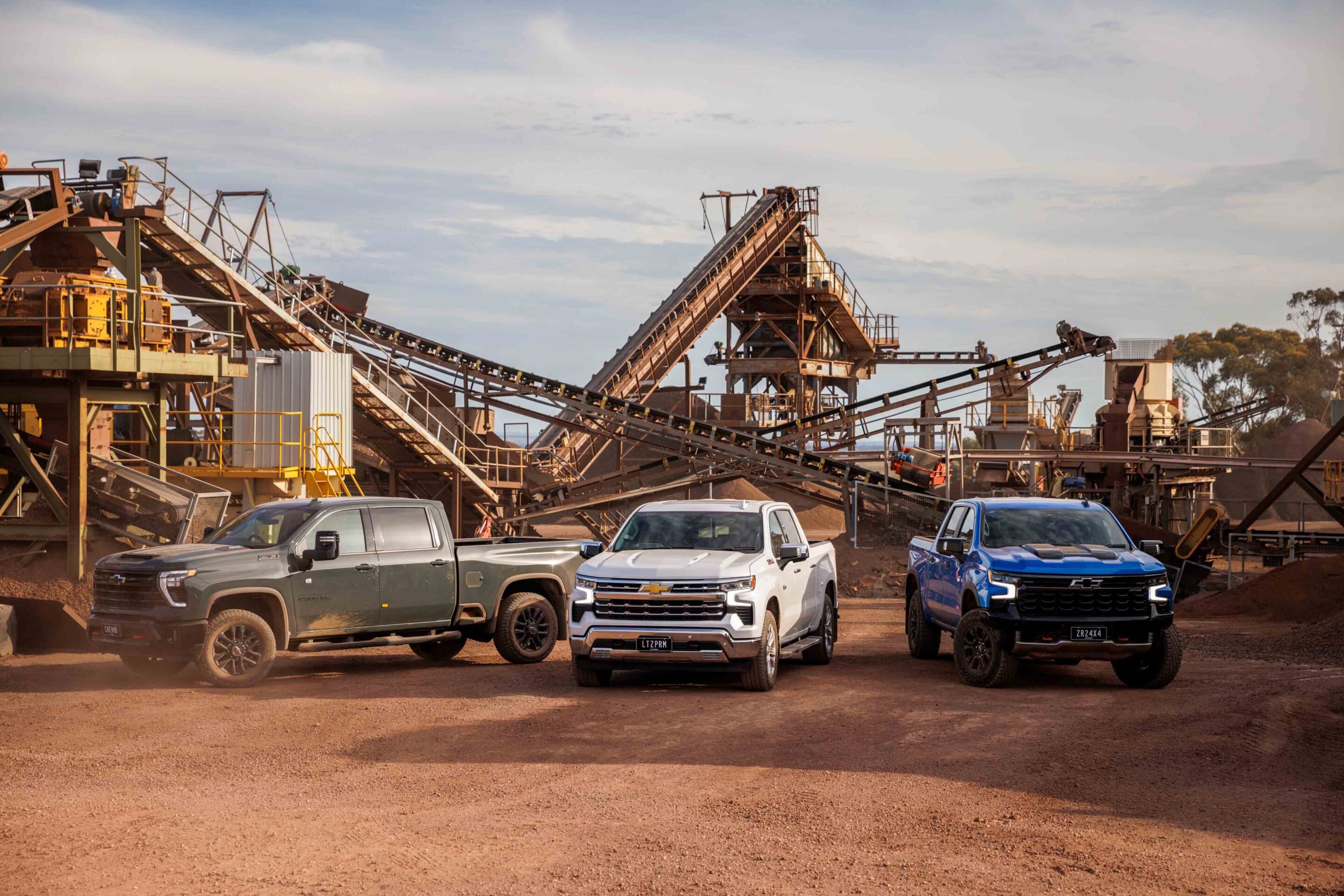
“We know how our owners love to use their Silverado, both during the working week and on the weekends, so introducing an unlimited-kilometre warranty is something we know they will love,” said Jess Bala, Managing Director of GM Australia and New Zealand.
“Whether they’re towing or touring, working hard or on a weekend away, the Silverado’s warranty coverage now matches their appetite for adventure, no matter where or how far they go.
“The Silverado is a vehicle with a reputation forged by strength, durability and trust, and its passionate owners know they can rely on their truck to get the job done, no matter how tough. This change cements that reputation even further.”
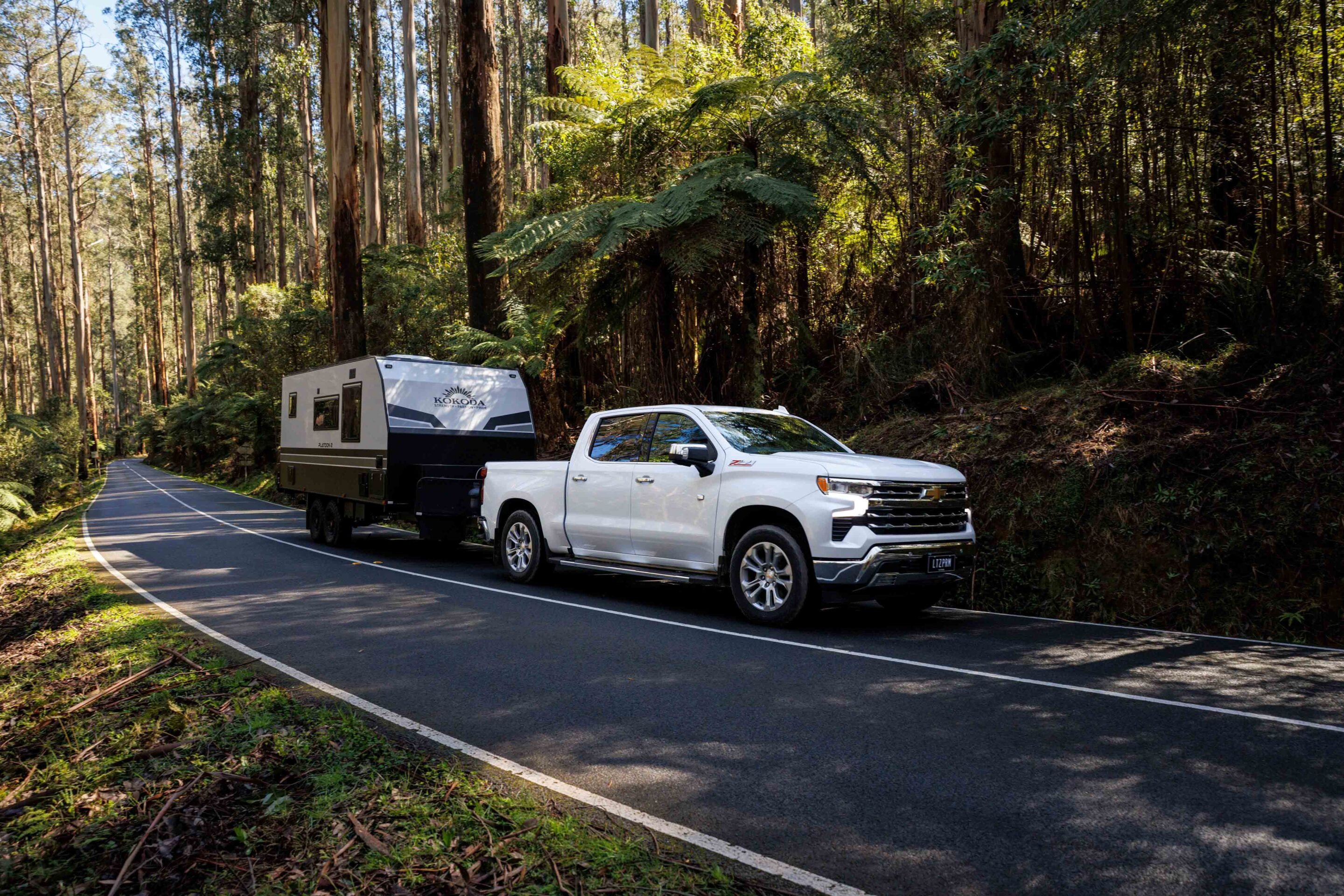
MY25 Silverado updates
Alongside the warranty boost, GMSV has rolled out minor updates for the MY25 Silverado range. The ZR2 now gains front park assist as standard, while two fresh paint options – Riptide Blue Metallic and Cypress Grey – join the ZR2’s colour palette.
Deliveries of the MY25 Silverado 1500 LTZ Premium and ZR2 have already begun across Australia and New Zealand, continuing through the final quarter of 2025.
Pricing
| Model | Pricing (excludes on-road costs) |
|---|---|
| Chevrolet Silverado 1500 LTZ Premium | $134,500 |
| Chevrolet Silverado 1500 ZR2 | $144,900 |
| Chevrolet Silverado 2500 HD | $168,000 |
Toyota’s next-generation HiLux appears to be on the verge of a showroom debut in Australia, following recent government filings that indicate the vehicle has passed local approval.
While Toyota has yet to confirm specifications, it appears the new HiLux could consolidate its engine range, with all Australian variants expected to use the 2.8-litre turbo-diesel four-cylinder 1GD-FTV. Two versions are suggested: a standard high-output model and a mild-hybrid variant, which could feature on higher-spec trims.
The filings also indicate a central front airbag for the driver and passenger, which would bring the HiLux closer to its key competitors in terms of occupant protection. The documents also reveal the extra-cab body style may be phased out.
Toyota is reportedly preparing to showcase the new HiLux in Thailand this November at the Motor Expo, where it may be marketed as the HiLux TRAVO. Leaked images of single- and dual-cab models show a refreshed front fascia with slimmer headlights, a revised grille, and updated rear lighting on dual-cabs. The overall proportions suggest a major facelift rather than a complete redesign, with the ute expected to remain on the existing IMV platform.
Inside, early glimpses point to a more advanced cabin, featuring dual 12.3-inch screens for both the instrument cluster and infotainment, with design cues drawn from the LandCruiser Prado. The diesel engines are expected to return with updates to meet emissions standards, while mild-hybrid and possibly a plug-in hybrid variant could join the lineup, keeping the HiLux competitive with rivals such as the Ford Ranger and BYD Shark.
Final specifications remain unconfirmed.
The Warrior sits in a funny position in the ute market. It’s not a Raptor rival, not a budget spec either.
It’s Nissan’s halo dual-cab, built here by Premcar, tuned for Aussie roads and bush, specced with tyres and suspension that actually work, and wrapped with the comfort of a full factory warranty.
I spent a week with it across SA, dragging an Offline Domino Camper 650km from Adelaide. Highways, coarse-chip blacktop, fast gravel, steep rocky climbs, and the Domino’s 1200kg hanging off the back – then we did the fun stuff. Unhitched we hit the Adelaide Hills 4WD Park and its Black-rated tracks to see how far you really can go on a stock Nissan.
JUMP AHEAD
- What does it come with?
- How it stacks up against rivals
- Engine and drivetrain
- Premcar suspension upgrades
- Off-road performance
- On-road performance
- Towing and payload
- Cabin and tech
- Safety features
- Warranty and servicing
- Recommended mods
- Verdict
- Specs
What does the PRO-4X Warrior come with?
The PRO-4X Warrior is Nissan’s flagship dual-cab ute in Australia.
Built on the PRO-4X, Premcar re-engineers suspension, protection, and rolling stock to suit Aussie conditions. This test included highway kays, rough bush tracks, and towing the Domino camper.
This isn’t just a Navara with stickers. Premcar reworks the already decent PRO-4X with new springs, dampers, jounce bumpers (progressive-rate bump stops), a specially designed towbar that clears a full-size spare, thicker bash plates, full underbody protection, and Cooper AT3 all-terrains.
Crucially, the whole package is ADR-approved and sold as a genuine Nissan, meaning you get the same five-year, unlimited-kilometre warranty and nationwide dealer support as any showroom Navara. That’s the Warrior’s ace – it gives you engineered upgrades without the aftermarket headaches.
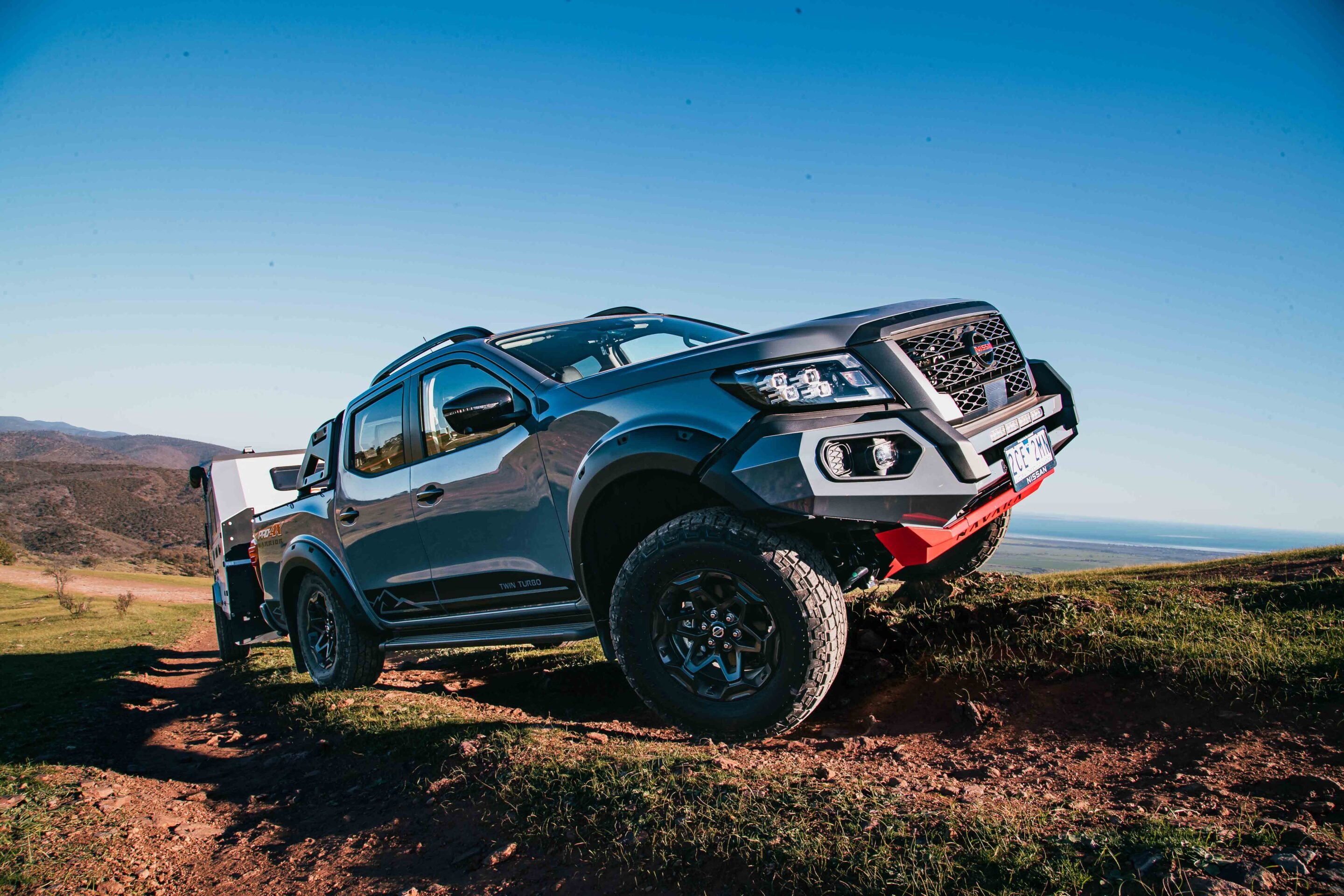
How it stacks up to rivals
The PRO-4X Warrior’s closest rivals sit at the premium end of the dual-cab spectrum: Toyota’s HiLux GR Sport, Isuzu’s D-MAX Blade, and Ford’s Ranger Wildtrak-X. Each takes a similar approach, they all land in the same buyer’s crosshairs.
The HiLux GR Sport is Toyota’s toughest showroom ute to date. At $73,990 plus on-roads, it’s a touch pricier than the Warrior once you’re on the road, but it justifies some of that with more power and torque. Its 2.8-litre diesel with 165kW/550Nm, giving it a healthy 100Nm advantage over the Warrior. On paper that matters for towing, though its 5850kg GCM is actually lower than Nissan’s, and its 735kg payload is pretty substandard. Its platform age is also showing: the GR Sport sits on the 2015-era HiLux chassis, with refinements but no clean-sheet changes.
The Isuzu D-MAX Blade, at $76,990 drive-away, is the most expensive of this trio but brings Walkinshaw’s suspension expertise to the table. Its 3.0-litre four-cylinder diesel (140kW/450Nm) matches the Warrior for outputs but is better known for durability than refinement. Payload is healthier than the GR-S at 970kg, and its 6000kg GCM gives it more practical towing headroom. The Blade’s strength is out-of-the-box off-road traction – thanks to Rough Terrain Mode and aggressive Goodyear Duratracs – though it too sits on a relatively new platform, launching in 2020.
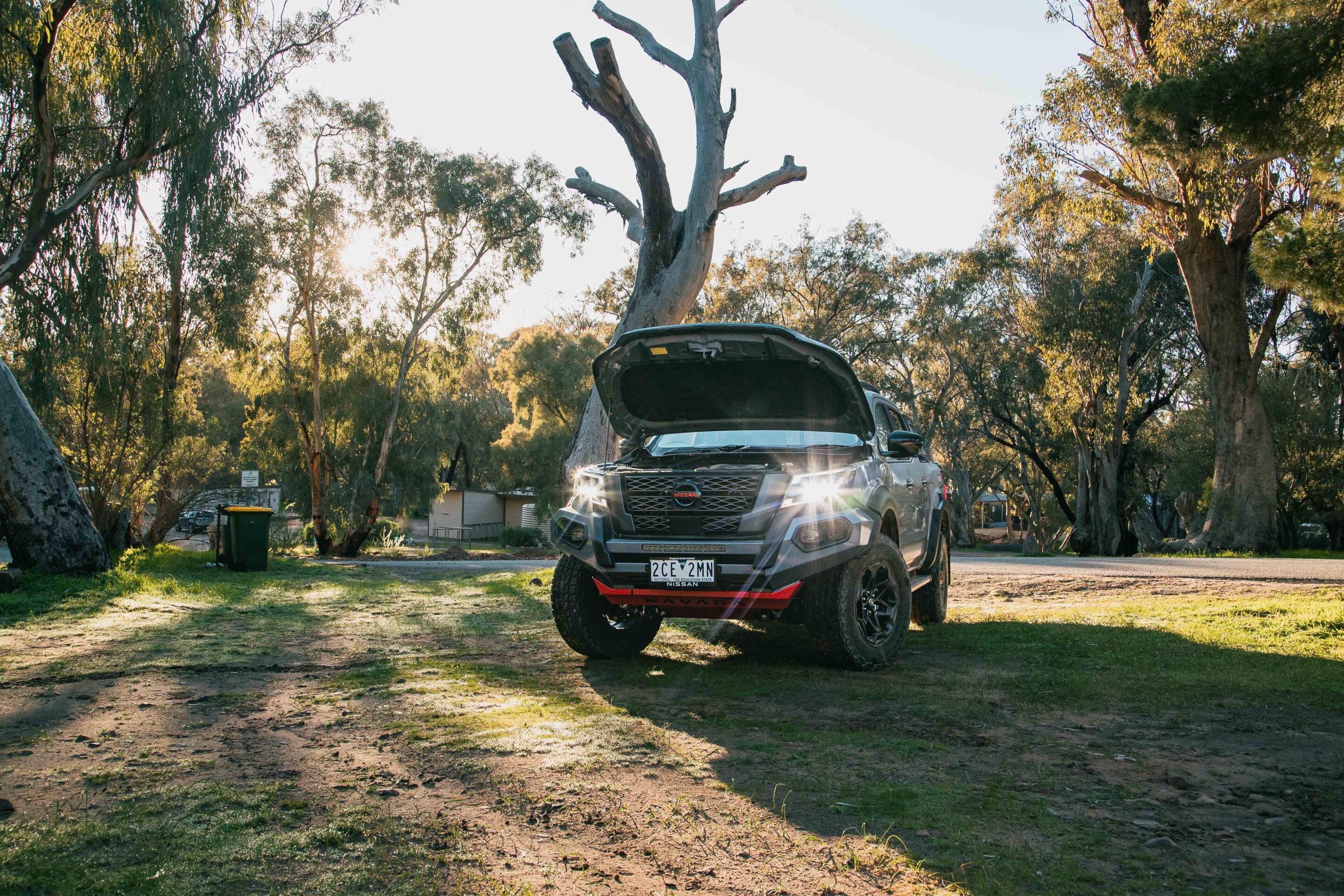
Then there’s the Ford Ranger Wildtrak-X, which debuted as a 2023MY and is the freshest of the bunch. At $75,990 plus on-roads, it’s a little pricier than the others but sits on an all-new chassis and body that make the Navara and HiLux feel dated. Its 2.0-litre bi-turbo (154kW/500Nm) splits the difference between Nissan and Toyota for outputs, and the 10-speed auto keeps it on song.
Payload comes in at 951kg, with a GCM of 6400kg – easily the best here for touring and towing. The Wildtrak-X also adds full-time 4WD and more modern safety tech, which makes the Warrior’s hydraulic steering and basic driver aids feel old-hat.
Taken together, the Warrior undercuts the competition slightly on price, and its suspension package is arguably better balanced for Aussie touring than either. But it cannot hide its 2014-era D23 platform. Against the brand-new Ranger, the Nissan feels like the older design it is – capable and confidence-inspiring, but a generation behind in cabin and driveline refinement.
Engine and drivetrain
Under the bonnet is the familiar 2.3-litre twin-turbo four-cylinder diesel, producing 140kW and 450Nm.
It’s paired with a seven-speed automatic and part-time 4WD with low range. Premcar doesn’t touch the driveline, and honestly, we wish they did. The Warrior feels engineered everywhere else, but the engine and gearbox are unchanged.
With the Domino behind, it holds 110km/h on the flat comfortably, but hills or overtakes expose the lack of grunt. Downshifts come quickly and while it hauls through, it’s never effortless. Compared to the HiLux GR Sport’s extra 100Nm or the Ranger V6’s 600Nm, the Warrior feels under-gunned.
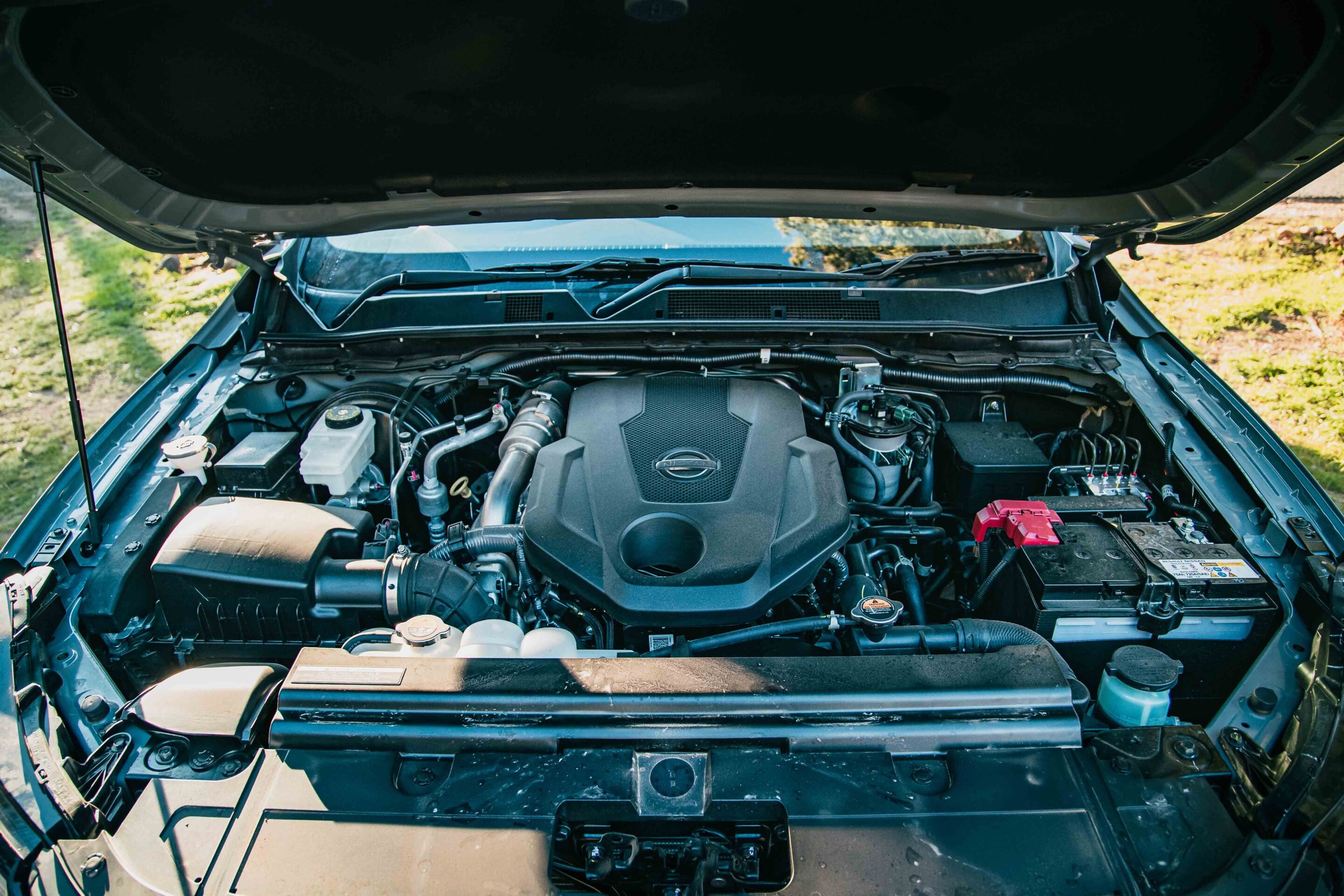
Unhitched, it’s adequate rather than exciting. Around town the twin-turbo setup delivers torque early, and the auto is tuned for smooth, lazy shifts. Hydraulic steering and part-time 4WD give it an old-school feel. Engage 4H on gravel and it feels surefooted, while low range creeps confidently. Traction control calibration is sharp, helping it punch above its spec sheet off-road.
Noise levels are better than expected for a ute on chunky LT Coopers. Tyre hum will increase as they wear, but out of the box it’s quieter than a D-MAX, though not as refined as a HiLux or Ranger V6. At the end of the day, the driveline is the Warrior’s limiting factor. More power would transform it from “capable” to “competitive.”
Premcar suspension upgrades
The Warrior’s suspension is its calling card, and it’s where Premcar’s fingerprints are most obvious. The work is not cosmetic – it’s real re-engineering.
Up front, the coil springs were softened by about 7%, allowing the front end to settle more naturally over small bumps and corrugations. Steering inputs feel calmer, with less kickback through the wheel, which pays dividends on long highway runs and when nosing into rocky climbs.
The rear uses a clever dual-rate progressive spring: the primary stage softened by around 6% for compliance over everyday bumps, while the secondary stage stiffened by about 13% to keep the ute level under payload or ball weight. In practice, it doesn’t sag badly when you hitch a camper, but it also doesn’t rattle your teeth when unladen. It is much smoother and compliant than any leaf-spring suspension in its class.
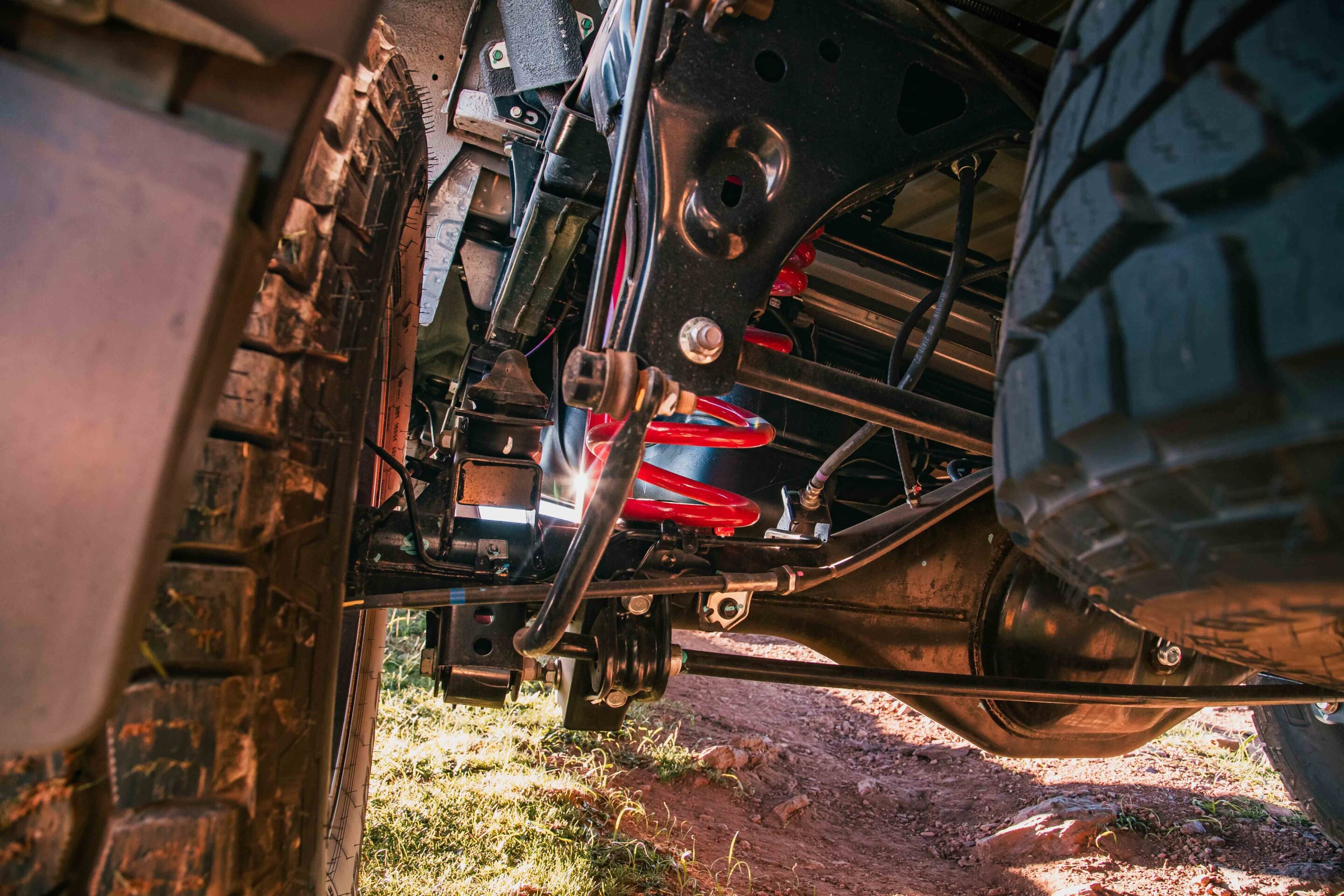
Larger-bore twin-tube shocks, tuned for the revised spring rates, add heat capacity and better control over long corrugated stretches. On test they resisted fade even after hours on fast gravel and kept the chassis composed with the Domino’s 150kg of ball load. The jounce bumpers (progressive-rate bump stops) deserve credit too: instead of a harsh thump when the suspension bottoms, they compress progressively, cushioning big hits.
All this adds roughly a 40mm lift over the PRO-4X. Ground clearance grows to 260mm, and approach, departure and breakover angles all improve. More importantly, the Warrior feels engineered to carry people and gear at speed across mixed terrain, not just bounce around like a commercial ute.
The rolling stock is equally well judged: 275/70R17 Cooper Discoverer AT3 LTs on Warrior-specific alloys. They’re load-rated, aggressive enough for clay and rock, and tough enough for sharp stones. Crucially, they’re matched to the suspension tune, avoiding the vague, floaty feel common when chunky tyres are bolted onto soft stock setups. On our SA test loop they gave consistent grip across blacktop and bush.
This suspension and tyre package is what sets the Warrior apart: less sag under load, more compliance unladen, and a level of stability that inspires confidence whether towing or touring.
Off-road performance
Ground clearance climbs to 260mm, with approach at 32°, departure at 19.8° and breakover at 23°.
On test, it walked through cross-axle sections with composure, traction control tuning is sharp, and articulation is solid. The Coopers made light work of clay and rock. Articulation isn’t LandCruiser or Prado level, but with nearly a tonne of payload capacity, that’s expected. What impressed was how planted the Warrior felt, with less axle hop and better control than rivals still running basic leaf packs.
I rarely needed the protection of the undercarriage armour – the clearance and decent departure and approach angles gave me plenty of line choice through the rocky Black-rated trails at Adelaide Hills 4WD Park. The turning circle is tight enough for switchbacks, though the heavier hydraulic steering is noticeable compared to the lighter, more modern systems in Ranger or D-MAX.
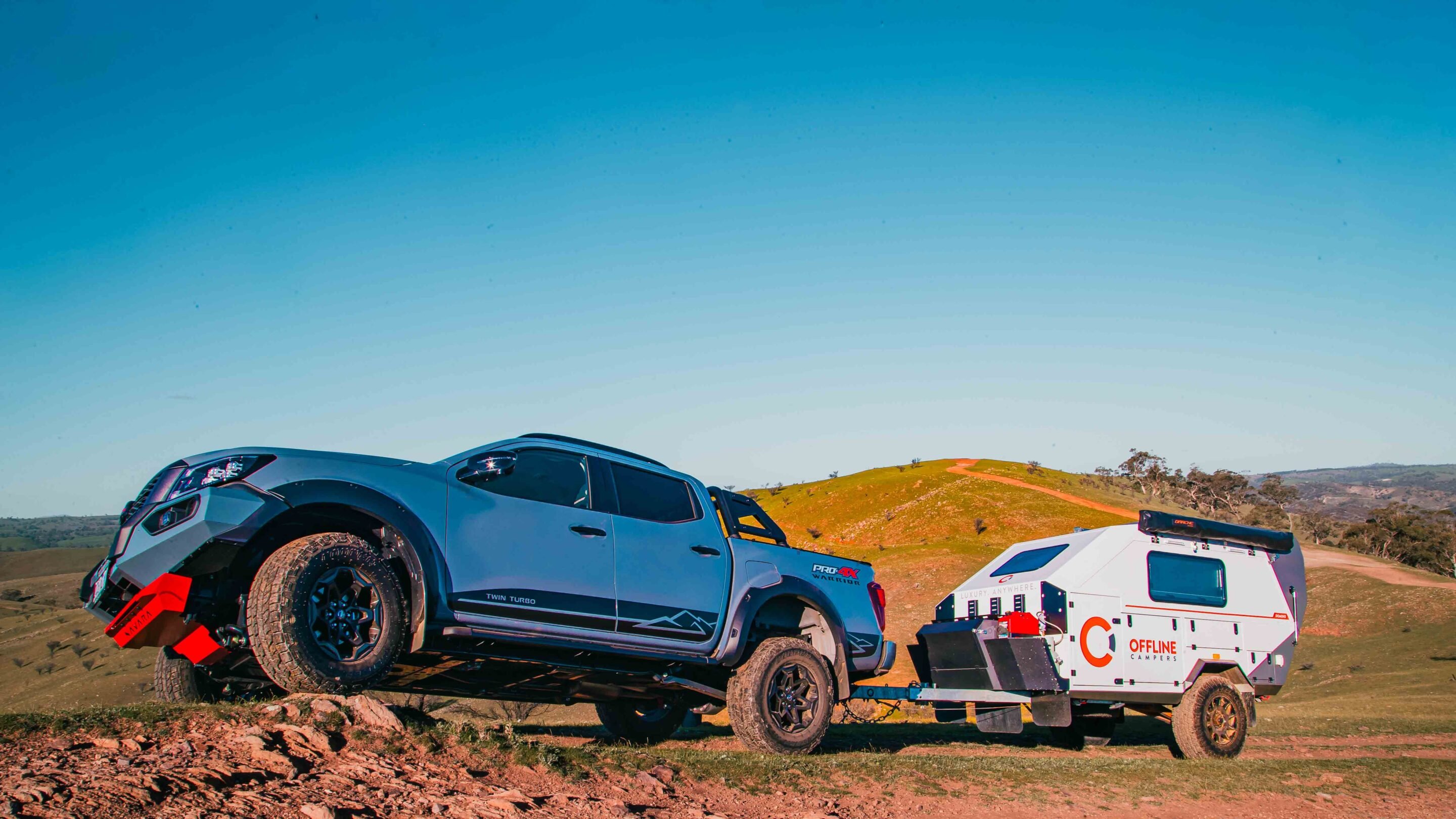
On-road comfort
A gripe here: the D23 feels made for smaller drivers. The seats could use more padding and the driving position isn’t great for taller people. Compared to a Ranger or D-MAX, it feels cramped and dated.
The ride, however, is a win. Softer coils tame harshness while the re-valved shocks and bump stops manage weight transfer well. Steering is slower than a Ranger but stable, and highway refinement is excellent for a ute on proper LT tyres.
I drove 650km with the Offline Domino hitched and 2500km without. Some utes – especially low-spec D-MAXs – need weight in the tub to ride properly. The Warrior doesn’t. With the Domino it felt more assured, with a touch more rear-end grip, but even unladen it’s one of the best-riding factory utes today, short of a Raptor.
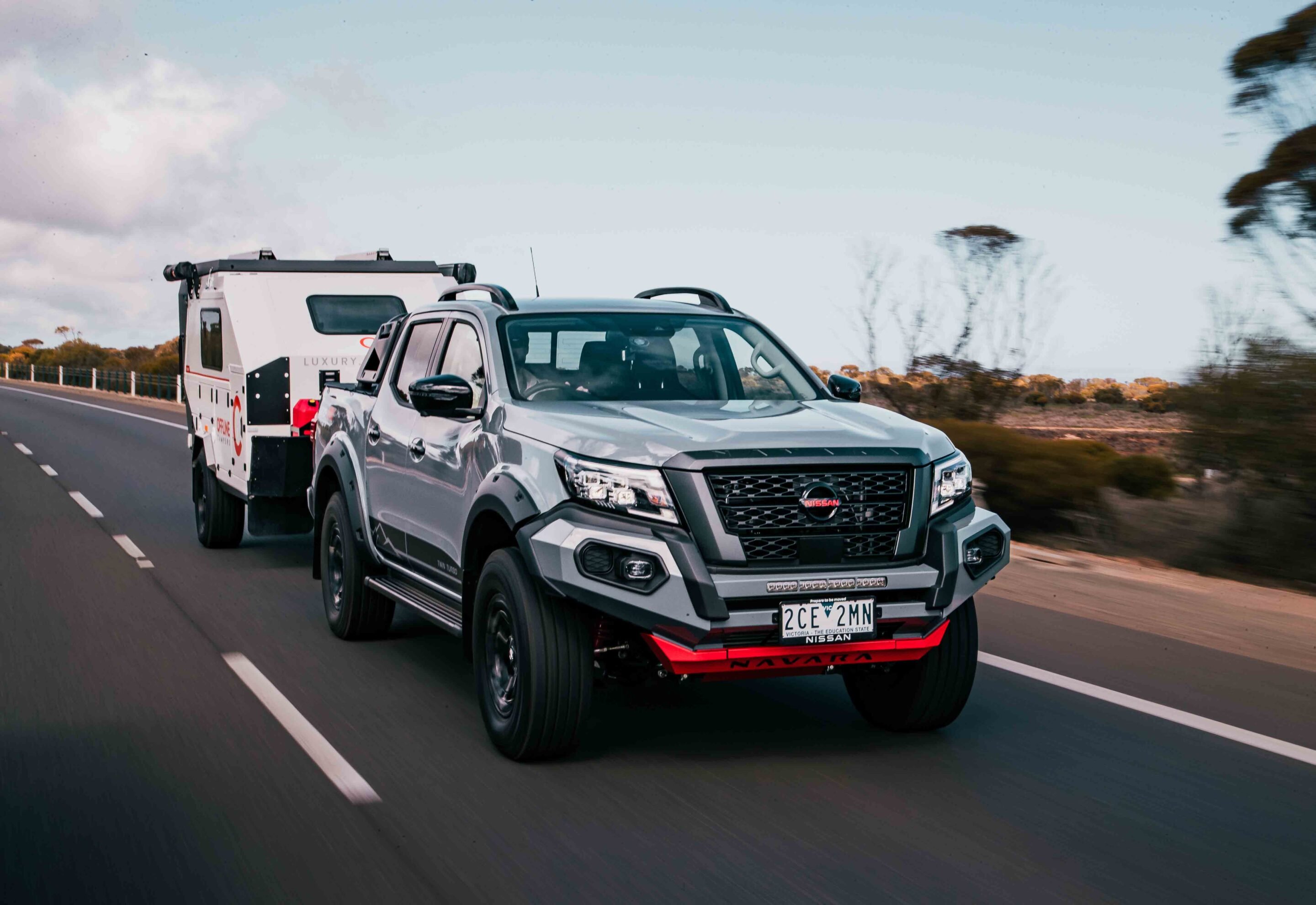
Towing and payload
With the Domino (ATM 1900kg, as seen ~1500kg) in tow, the Warrior was composed.
Reasonable low-end torque, stable suspension, and good cooling. It was not hot in SA this trip at around 15–25°C although we did punch a big headwind running up to Port Germain and the temperature needle did not move.
However, the Nav claims a big 3500kg maximum braked tow capacity. Will it do it? Yes, but you wouldn’t. Subtract the max tow capacity and your kerb weight (2298kg) from the 5910kg GCM and you’re working with 112kg for passengers and gear. The Warrior is best for towing up to 2500kg which will afford you your full payload (900kg) minus your ball weight; much better.
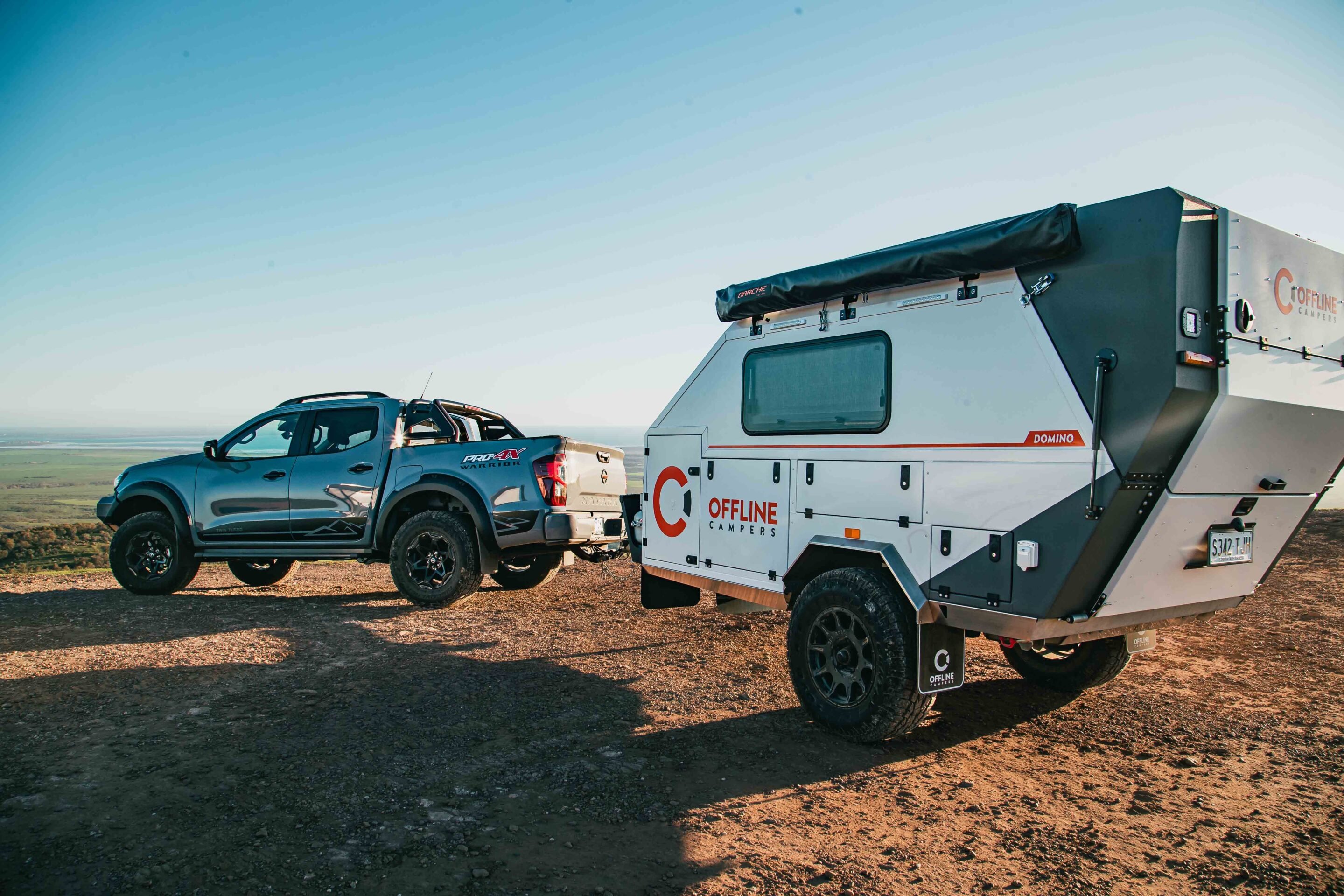
Cabin and tech
The D23 launched in 2014 and it feels it. Iterative updates have added some key tech like autonomous emergency braking and CarPlay, but like the Y62 Patrol, the interior is feeling old and outdone by its rivals.
Some will love that though as there is no intrusive lane departure assistance, just a beep when you cut road markings, and there is no driver alertness monitoring to give you the shits every time you look in the mirror or wear sunglasses.
It has leather-accented seats, an 8.0-inch infotainment screen with wired Apple CarPlay/Android Auto, and a dated but functional dash. Storage is a bit light on and the screen feels small compared to Ranger/Amarok and D-MAX. Comfort is fine for four adults, tight for five, but you’ll be fighting for USB plugs with only one and a cig point in the dash and a pair inside the centre console. If you are running a powered brake controller, phone and navigator, you’ll be frustrated like I was.
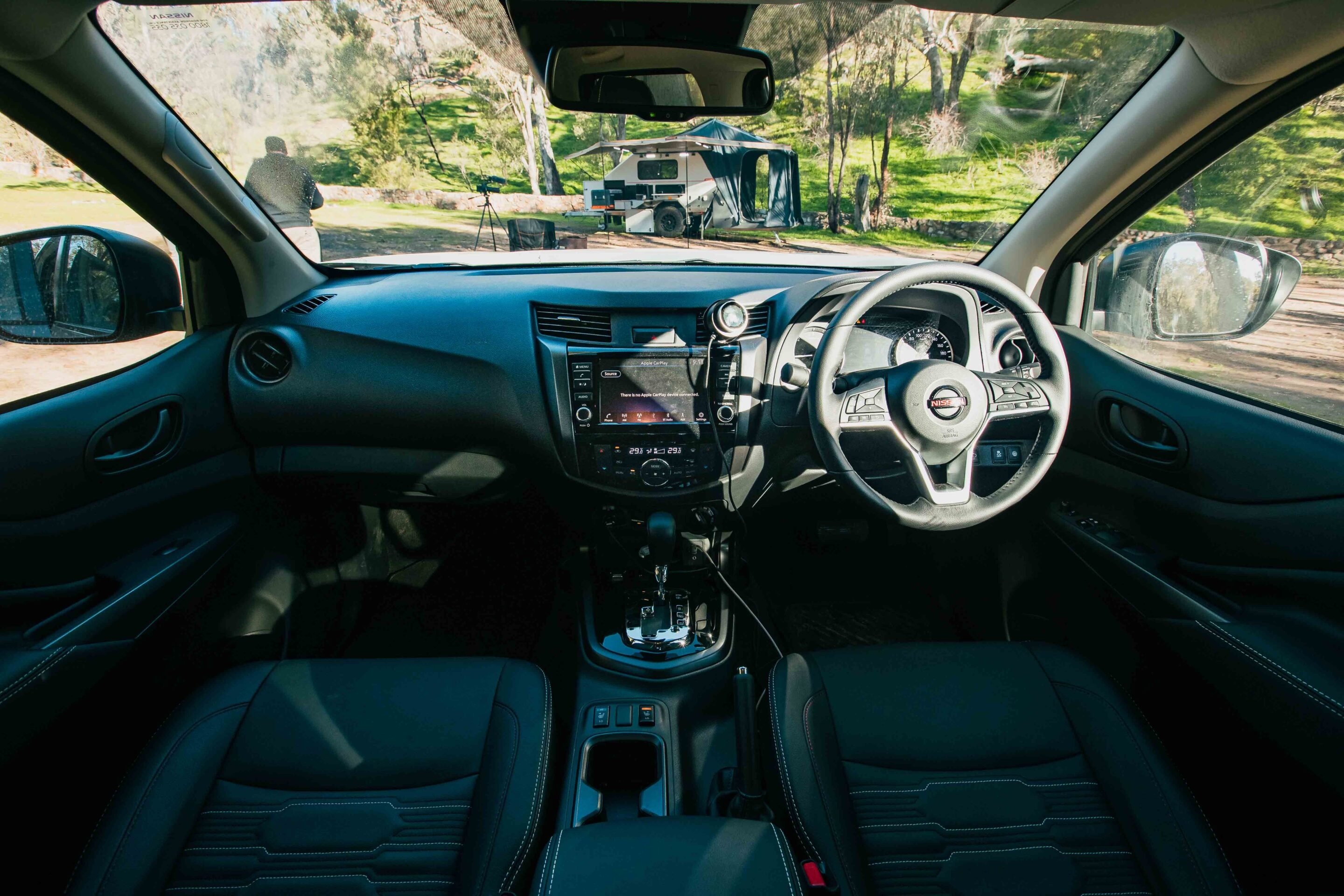
Safety features
Standard kit includes AEB, blind-spot monitoring, RCTA, lane departure warning, and 360-degree camera. Adaptive cruise is absent, and lane keep is advisory rather than active. A basic suite overall, though the 360-degree camera is a great touch even if low-definition.
Of course it has ABS and ESC which seemed fine in normal conditions. Off-road it has a dedicated Offroad Mode that holds gears right to the point of stalling – this cannot be understated enough as it really makes a difference in tight rocky tracks like we had. If the driveline is moving through gears a lot, it can jerk and cause slip at the tyres. I really enjoyed the control of the Warrior in low-speed climbs. The forward-facing and passenger-side cameras also show on the main screen when in OR mode and travelling slow, great for picking lines and avoiding the worst of the sharp rocks.
When towing there is a Tow Mode that also holds gears a bit longer, good for descents and helping keep transmission oil temps down. There is a Sport Mode but this is no Ranger Raptor. Why it has it and why you’d use it beats me.
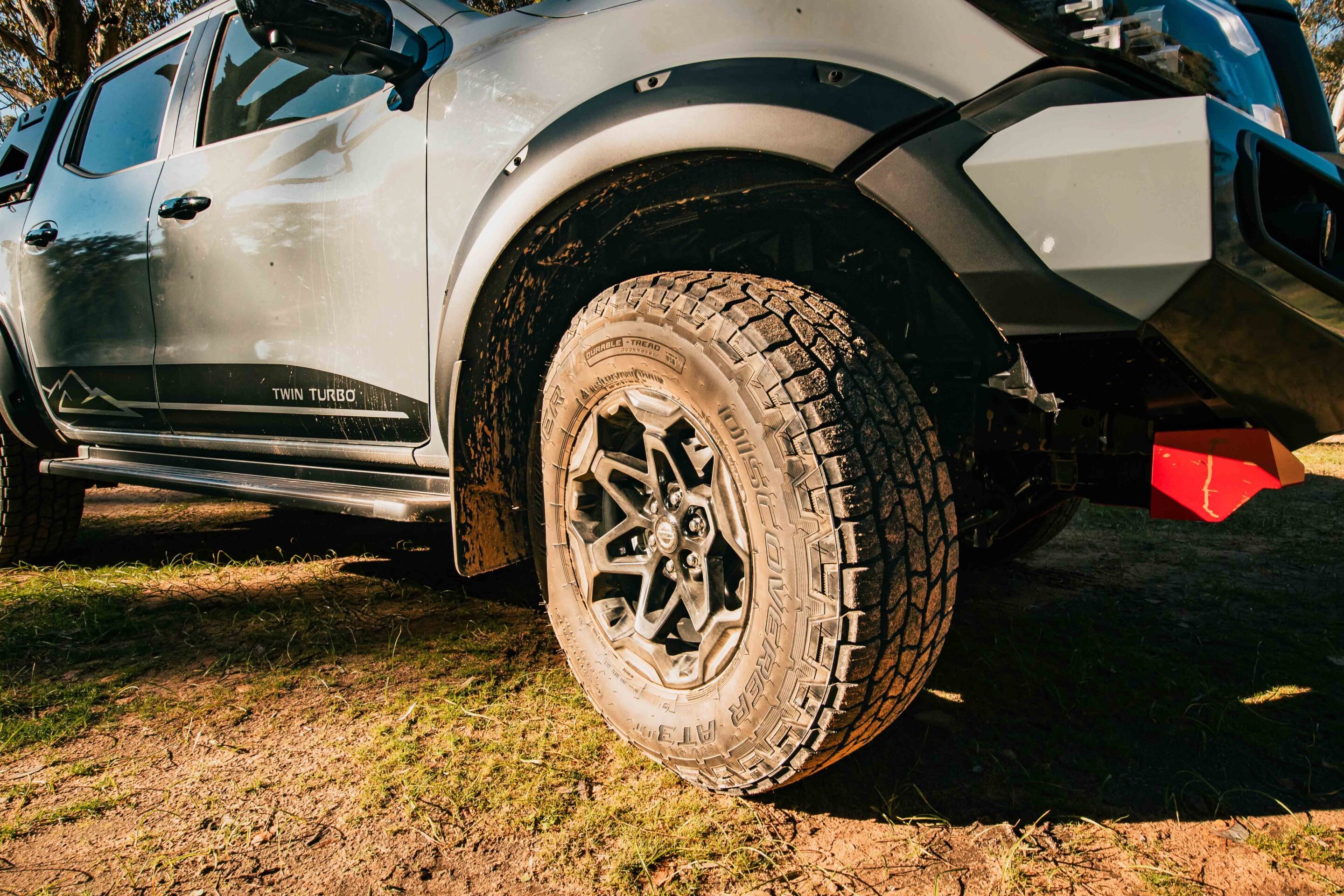
Warranty and servicing
One of the Warrior’s strongest suits is its ownership package, which stacks up well against the competition.
It’s backed by a five-year, unlimited-kilometre warranty and Nissan’s capped-price servicing program. Service intervals are set at 12 months or 20,000km, which is class-leading in the ute segment. For anyone clocking up highway kays or touring regularly, that means fewer trips back to the dealer and more time on the road. Across 100,000km, the Warrior requires just five dealer visits, costing around $3,500–$3,800 in total – roughly $700–$760 per year.
That’s competitive against the HiLux, which needs 10 visits in the same period, at a similar total cost but with double the downtime. The D-MAX undercuts both at around $2,200-$2,400 over five years, thanks to cheaper capped-price servicing, while Ford’s Ranger sits in the middle with 15,000km intervals and slightly higher costs.
Premcar’s involvement doesn’t void any of that coverage either. The Warrior is sold and backed as a genuine Nissan model, not a dealer special, so you get the reassurance of nationwide parts, dealer support and roadside assistance. For buyers worried about warranty fights on suspension mods, that peace of mind is a big drawcard.
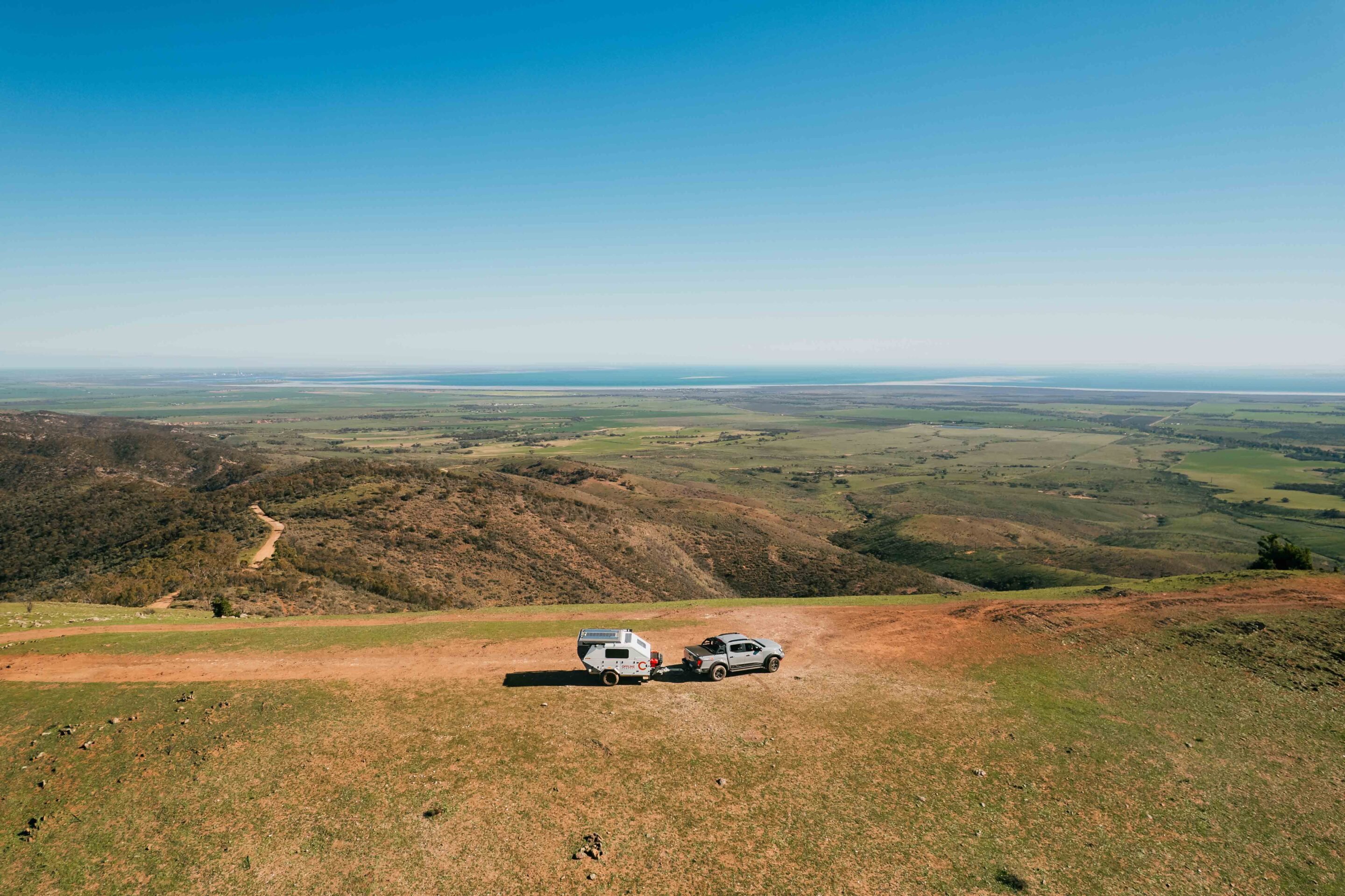
Recommended mods
The fuel tank is the obvious one. 65L is just not enough in this day and age. ARB offers a 138L Frontline tank – I would get this the day I took delivery.
The standard tyres are good enough, I would not recommend swapping them out. The same can be said of the LED lightbar and bash plates. The front bar looks hot as hell (I think this is the best-looking ute in its class) but although Nissan specs said it was winch-ready, I could not see a mounting plate on our test rig so maybe you’ll want to swap to a different front bar and winch. A power system would be a good option for anyone wanting a fridge and there is a decent space under rear seats (and behind) for a slimline setup.
The fabric tonneau cover would go in the bin for me. I’d get a tub-seal kit, some MSA drawers and a Utemaster Load-Lid – that would chew up 120kg before filling them but it would be worth it to carry a RTT or bikes. Fitting a GME XRS UHF would be a good fit for the Navara as you can fit a pass-through for the handpiece in the blanks on the lower edge of the dash and hide the handpiece in the centre console when not in use.
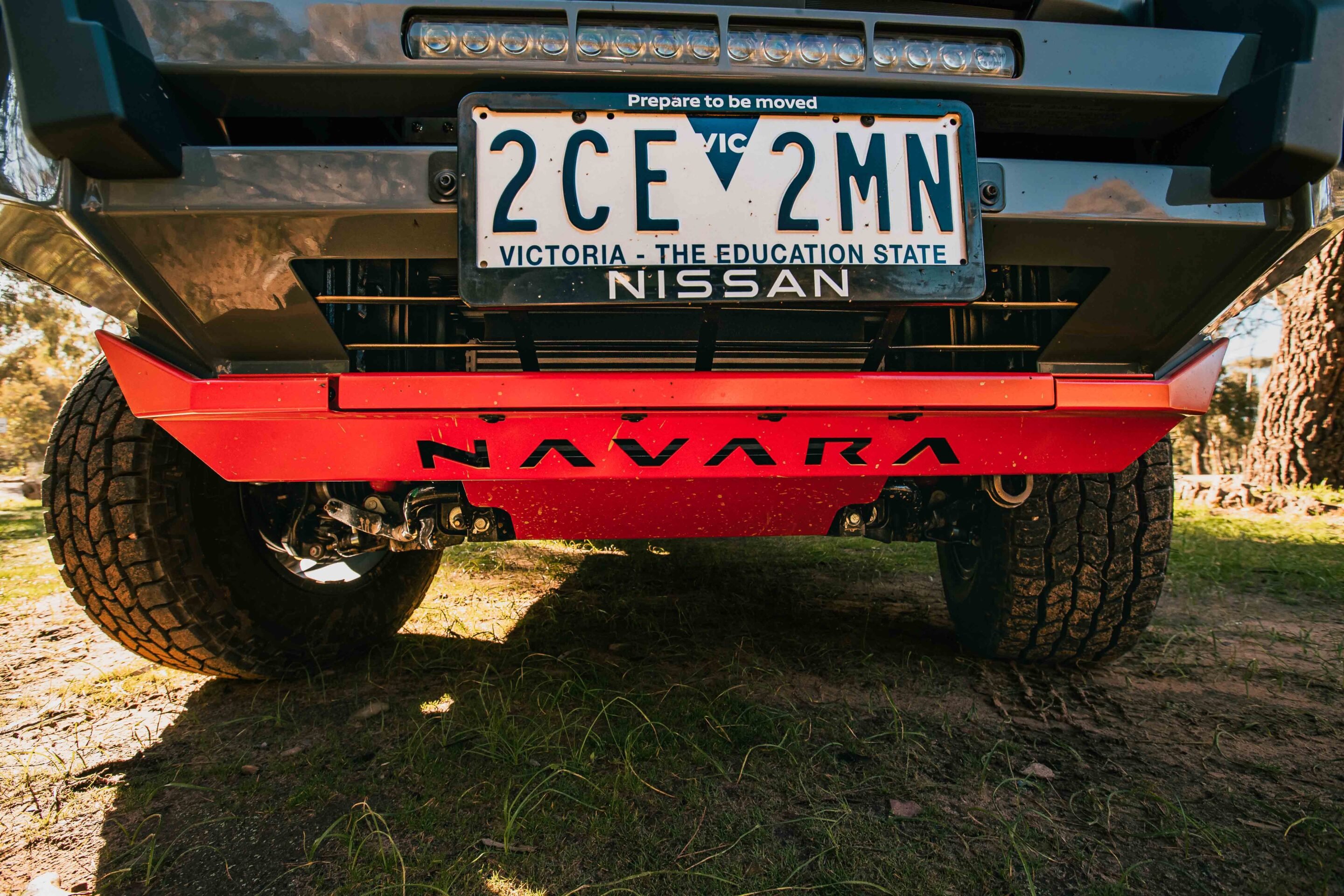
Verdict
The PRO-4X Warrior is not perfect – the cabin feels dated and cramped, and the driveline lacks the punch of newer rivals – but it’s also the most fun I’ve had in a ute since a Raptor.
It towed better than I expected, riding flat and stable with a camper in tow, and out on tracks the Premcar suspension makes it feel tougher than the spec sheet suggests. Price and servicing costs sit right alongside its competitors, but none look as good parked in the driveway. The Warrior still delivers honest, turn-key Aussie adventure appeal.
Specs
| Specification | Details |
|---|---|
| Model | Nissan Navara PRO-4X Warrior |
| Price | $67,515 + ORC (~$72-73K drive-away) |
| Engine | YS23DDTT 2.3L twin-turbo 4cyl diesel |
| Capacity | 2298cc |
| Max Power | 140kW @ 3750rpm |
| Max Torque | 450Nm @ 1500–2500rpm |
| Transmission | 7-speed automatic |
| 4×4 System | Part-time 4WD + rear diff lock |
| Crawl Ratio | Approx. 2.7:1 |
| Construction | Body-on-frame |
| Front Suspension | Independent double wishbone, coil springs, twin-tube shocks |
| Rear Suspension | Progressive rate springs, twin-tube shocks |
| Tyres | 275/70R17 Cooper Discoverer AT3 LT-AT |
| Kerb Weight | 2298kg |
| GVM | 3250kg |
| GCM | 5910kg |
| Towing Capacity | 3500kg (braked) |
| Payload | 952kg |
| Seats | 5 |
| Fuel Tank | 65L |
| ADR Fuel Consumption | 8.0L/100km |
| On-Test Consumption (Towing) | ~13.5L/100km |
| On-Test Consumption (Unhitched) | ~9L/100km |
| Approach Angle | 32 |
| Departure Angle | 19.8 |
| Breakover Angle | 23.3 |
| Ground Clearance | 260mm |
| Wading Depth | 600mm |